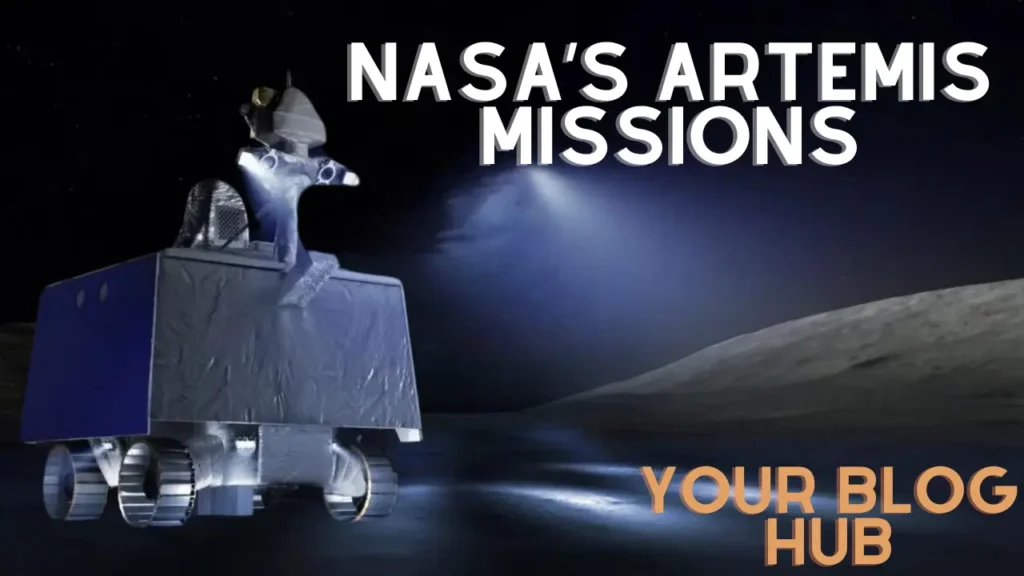Delve into NASA’s Artemis Missions, where advanced AI takes center stage in unlocking lunar mysteries. Explore the profound role of artificial intelligence in shaping and revolutionizing the future of lunar exploration and the quest to return to the moon’s enigmatic surface.
Table of Contents

NASA, the eminent National Aeronautics and Space Administration, has its sights set on a remarkable endeavor—the Artemis missions—a daring initiative aiming to ferry humans back to the moon’s enigmatic terrain. Central to this bold pursuit is the amalgamation of cutting-edge artificial intelligence (AI) technology, notably embodied in the Volatiles Investigating Polar Exploration Rover (VIPER) project.
VIPER Rover: Pioneering Lunar Terrain Exploration with AI Precision
The VIPER rover, meticulously crafted for a celestial touchdown on the lunar expanse of Mons Mouton, is poised for an extensive 100-day odyssey, delving deep into the uncharted territories of the moon’s southern pole. At its core, this mission harbors a pivotal objective—to unravel the intricate distribution of water on the lunar surface and decipher the evolution of lunar volatiles, elements characterized by their low boiling points.
However, VIPER’s AI prowess isn’t reminiscent of the sentient robots depicted in the realms of science fiction. Instead, it epitomizes adaptability, flexibility, durability, and efficiency—traits finely tuned to confront and conquer the challenges posed by the lunar environment. NASA perceives AI as a formidable instrument, adept at navigating the uncertainties and rugged terrains of the moon’s landscape.
SHERPA: Mastermind AI Steering VIPER's Expedition
At the heart of VIPER’s AI capabilities lies the System Health Enabled Real-time Planning Advisor (SHERPA), an indispensable entity orchestrating critical decision-making processes. SHERPA assumes a pivotal role in the mission’s operations by simulating diverse route options and meticulously assessing associated risks. This AI component has been instrumental in meticulously charting out the mission’s trajectory, poised to continuously play a decisive role in implementing real-time alterations during the operation.
The interplay between AI and human decision-makers forms a symbiotic loop—a harmonious synergy where AI sketches the blueprint and human intervention refines it, accounting for practical limitations and on-ground exigencies.
Temporal Constraint Planning: AI's Tactical Toolset in Mission Execution
VIPER will also employ temporal constraint planning, a subfield of AI, to manage mission activities within the set timeframe. This method allows for intelligent planning and scheduling, ensuring that the mission’s objectives are met within the prescribed period.
The VIPER mission stands as a testament to the synergy of AI and human expertise in advancing space exploration. It paves the way for future missions that will further incorporate these technologies, revolutionizing our understanding of the moon and setting the stage for mankind’s return to the lunar surface.
The Nexus of AI and Human Ingenuity: Pioneering Future Lunar Odyssey
The VIPER mission stands as a testament to the profound amalgamation of AI sophistication and human expertise, propelling the frontiers of space exploration to unprecedented heights. This groundbreaking venture heralds a new era, laying the groundwork for forthcoming missions poised to seamlessly integrate these transformative technologies. In doing so, it not only reshapes our comprehension of the lunar landscape but also sets the stage for humanity’s triumphant return to the lunar surface—a testament to our unwavering commitment to unraveling the cosmos’ enigmatic mysteries.
Frequently Asked Questions (FAQs) about VIPER Mission:
1. What is the primary objective of the VIPER mission?
The VIPER mission aims to delve into the moon’s southern pole, specifically Mons Mouton, to investigate and analyze the distribution of water and the evolution of lunar volatiles within a 100-day timeframe.
2. How does VIPER’s AI technology contribute to the mission?
VIPER’s AI technology, particularly the SHERPA system, plays a pivotal role in decision-making by simulating route choices, assessing risks, and facilitating real-time adjustments during the mission. It assists in navigating the challenging lunar terrain and uncertainties.
3. What distinguishes VIPER’s AI from typical science fiction depictions of AI?
Unlike science fiction portrayals of sentient robots, VIPER’s AI is designed to be adaptable, flexible, durable, and efficient. It serves as a tool to handle the complexities of the lunar landscape rather than an autonomous entity.
4. How does temporal constraint planning aid VIPER’s mission activities?
Temporal constraint planning, a specialized AI subfield, enables intelligent planning and scheduling of mission activities within the designated timeframe. It ensures that objectives are met efficiently within the set period.
5. What is the significance of the collaboration between AI and human decision-makers in this mission?
The collaboration between AI and human decision-makers forms a symbiotic relationship, with AI providing a blueprint that humans refine based on practical limitations and real-time conditions. This cooperation optimizes mission strategies and responses.
6. How does the VIPER mission contribute to the future of lunar exploration?
The VIPER mission serves as a milestone, showcasing the effective integration of AI and human expertise in space exploration. Its success paves the way for future missions that will further leverage these technologies, revolutionizing our understanding of the moon and preparing for humanity’s return to its surface.
7. How does the VIPER mission impact our understanding of lunar resources?
VIPER’s exploration of the moon’s water distribution and volatiles sheds light on potential resources that could support future lunar missions. Understanding these elements is crucial for sustaining human activities on the moon.
8. What challenges does the lunar south pole terrain pose for the VIPER rover?
The lunar south pole terrain presents rugged landscapes, extreme temperature variations, and possible communication limitations due to its location. VIPER’s AI is engineered to adapt to these challenges for effective exploration.
9. What are the potential implications of VIPER’s findings on future space missions?
Insights gathered by VIPER could influence future mission planning by providing valuable data on lunar surface conditions, potentially identifying suitable locations for human habitats or resource extraction.
10. How does VIPER’s collaboration between AI and human decision-makers ensure mission success?
The synergy between AI and human decision-makers allows for comprehensive mission planning. AI assists in data analysis and navigation, while human expertise provides contextual understanding, enabling adaptable and informed decision-making.
11. How does NASA mitigate the risks associated with VIPER’s mission on the moon?
NASA employs meticulous risk assessments and simulations using AI models like SHERPA to anticipate and navigate potential hazards, ensuring the safety and success of VIPER’s operations.
12. What are the long-term implications of VIPER’s mission for space exploration beyond the moon?
VIPER’s mission sets a precedent for integrating AI technologies into space exploration, offering insights into how AI-human collaboration can be leveraged for future missions to distant celestial bodies, potentially revolutionizing space exploration methodologies.
13. How does VIPER’s exploration contribute to scientific advancements beyond lunar studies?
VIPER’s findings hold implications beyond lunar exploration, potentially advancing our understanding of volatile elements and water distribution in other celestial bodies, aiding broader space research.
14. What technological advancements enable VIPER’s operational success on the moon?
VIPER leverages cutting-edge AI technology, robust communication systems, durable materials, and precision instruments tailored for lunar exploration, ensuring its efficacy in the challenging lunar environment.
15. How does VIPER’s 100-day mission timeline impact its objectives and findings?
The 100-day mission timeline drives VIPER’s efficiency and urgency in data collection and analysis. It prioritizes key objectives while allowing flexibility for real-time adjustments.
16. In what ways does VIPER’s AI facilitate adaptability to unforeseen lunar conditions?
VIPER’s AI capabilities enable adaptive decision-making by processing real-time data and adjusting exploration strategies to navigate unexpected lunar conditions, ensuring mission continuity.
17. How does NASA ensure ethical and responsible use of AI in the VIPER mission?
NASA adheres to strict ethical guidelines and programming protocols, ensuring AI functions within predefined parameters and respects environmental considerations on the moon.
18. What are the collaboration benefits between VIPER’s AI technology and international space agencies?
Collaboration with international space agencies allows for knowledge exchange and diverse perspectives, potentially enhancing VIPER’s mission outcomes through shared expertise and resources.
19. How does VIPER’s mission align with NASA’s broader goals for lunar exploration and beyond?
VIPER’s mission aligns with NASA’s vision for sustainable lunar exploration, laying the groundwork for future manned missions and establishing precedents for similar endeavors on other celestial bodies.
20. How can the public engage with or follow VIPER’s mission progress and findings?
NASA provides regular updates, mission logs, and educational resources on their platforms, enabling the public to track VIPER’s journey and discoveries, fostering interest and understanding of lunar exploration.



